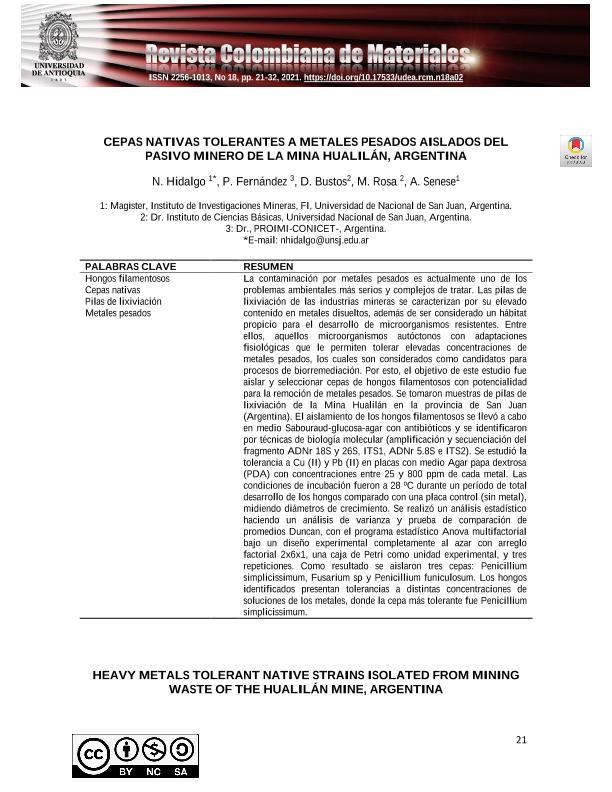Mostrar el registro sencillo del ítem
dc.contributor.author
Hidalgo, Natalia

dc.contributor.author
Fernandez, Pablo Marcelo

dc.contributor.author
Bustos, D.
dc.contributor.author
Rosa, M
dc.contributor.author
Senese, Armando Omar

dc.date.available
2022-07-05T14:03:07Z
dc.date.issued
2021-03
dc.identifier.citation
Hidalgo, Natalia; Fernandez, Pablo Marcelo; Bustos, D.; Rosa, M; Senese, Armando Omar; Heavy metals tolerant native strains isolated from mining waste of the Hualilán mine, Argentina; Universidad Nacional de Colombia; Revista Colombiana de Materiales; 3-2021
dc.identifier.issn
2256-1013
dc.identifier.uri
http://hdl.handle.net/11336/161292
dc.description.abstract
Heavy-metal contamination is one of the most serious and complex environmental problems to be dealt with nowadays. Leaching piles from the mining industry are characterized by a high content of dissolved metals. In addition, they are considered to be a suitable habitat for the development of resistant microorganisms. Among such microorganisms are those native ones that are physiologically adapted to tolerate high concentrations of heavy metals and thus, are considered to be candidates for bioremediation processes. Taking this into consideration, the aim of this study was to isolate and select filamentous fungal strains with the potential to remove heavy metals. Samples of leaching piles were drawn from Hualilán Mine in the province of San Juan (Argentina). Isolation of filamentous fungi was carried out in a Sabouraud-glucose-agar medium with antibiotics, and the fungi were identified by using molecular biology techniques (amplification and sequencing of the fragment ADNr 18S y 26S, ITS1, ADNr 5.8S e ITS2). Tolerance to Cu (II) and Pb (II) was studied in plates with Potato dextrose agar (PDA) medium with concentrations between 25 and 800 ppm of each metal. Incubation conditions were at 28 °C during the period of total development of the fungi and compared with a control plate (without metal) by measuring growth diameters. A statistical analysis was carried out through variance analysis and Duncan means comparison test, with the ANOVA multifactor statistical software under a completely randomized experimental design with 2x6x1 factorial arrangement, a Petri dish as an experimental unit, and three repetitions. As a result, three strains were isolated, namely, Penicillium simplicissimum, Fusarium sp and Penicillium funiculosum. The fungi identified show tolerances to different concentrations of metal solutions, the most tolerant strain being Penicillium simplicissimum.
dc.description.abstract
La contaminación por metales pesados es actualmente uno de los problemas ambientales más serios y complejos de tratar. Las pilas de lixiviación de las industrias mineras se caracterizan por su elevado contenido en metales disueltos, además de ser considerado un hábitat propicio para el desarrollo de microorganismos resistentes. Entre ellos, aquellos microorganismos autóctonos con adaptaciones fisiológicas que le permiten tolerar elevadas concentraciones de metales pesados, los cuales son considerados como candidatos para procesos de biorremediación. Por esto, el objetivo de este estudio fue aislar y seleccionar cepas de hongos filamentosos con potencialidad para la remoción de metales pesados. Se tomaron muestras de pilas de lixiviación de la Mina Hualilán en la provincia de San Juan (Argentina). El aislamiento de los hongos filamentosos se llevó a cabo en medio Sabouraud-glucosa-agar con antibióticos y se identificaron por técnicas de biología molecular (amplificación y secuenciación del fragmento ADNr 18S y 26S, ITS1, ADNr 5.8S e ITS2). Se estudió la tolerancia a Cu (II) y Pb (II) en placas con medio Agar papa dextrosa (PDA) con concentraciones entre 25 y 800 ppm de cada metal. Las condiciones de incubación fueron a 28 ºC durante un período de total desarrollo de los hongos comparado con una placa control (sin metal), midiendo diámetros de crecimiento. Se realizó un análisis estadístico haciendo un análisis de varianza y prueba de comparación de promedios Duncan, con el programa estadístico Anova multifactorial bajo un diseño experimental completamente al azar con arreglo factorial 2x6x1, una caja de Petri como unidad experimental, y tres repeticiones. Como resultado se aislaron tres cepas: Penicillium simplicissimum, Fusarium sp y Penicillium funiculosum. Los hongos identificados presentan tolerancias a distintas concentraciones de soluciones de los metales, donde la cepa más tolerante fue Penicillium simplicissimum.
dc.format
application/pdf
dc.language.iso
eng
dc.publisher
Universidad Nacional de Colombia
dc.rights
info:eu-repo/semantics/openAccess
dc.rights.uri
https://creativecommons.org/licenses/by-nc-sa/2.5/ar/
dc.subject
FILAMENTOUS FUNGI
dc.subject
NATIVE STRAINS
dc.subject
LEACHING PILES
dc.subject
HEAVY METALS
dc.subject.classification
Minería y Procesamiento Mineral

dc.subject.classification
Ingeniería del Medio Ambiente

dc.subject.classification
INGENIERÍAS Y TECNOLOGÍAS

dc.title
Heavy metals tolerant native strains isolated from mining waste of the Hualilán mine, Argentina
dc.title
Cepas nativas tolerantes a metales pesados aislados del pasivo minero de la mina Hualilán, Argentina
dc.type
info:eu-repo/semantics/article
dc.type
info:ar-repo/semantics/artículo
dc.type
info:eu-repo/semantics/publishedVersion
dc.date.updated
2022-07-04T19:55:04Z
dc.journal.pais
Colombia

dc.journal.ciudad
Bogotá
dc.description.fil
Fil: Hidalgo, Natalia. Universidad Nacional de San Juan; Argentina
dc.description.fil
Fil: Fernandez, Pablo Marcelo. Consejo Nacional de Investigaciones Científicas y Técnicas. Centro Científico Tecnológico Conicet - Tucumán. Planta Piloto de Procesos Industriales Microbiológicos; Argentina
dc.description.fil
Fil: Bustos, D.. Universidad Nacional de San Juan; Argentina
dc.description.fil
Fil: Rosa, M. Universidad Nacional de San Juan. Facultad de Ingenieria. Departamento de Ingenieria Agronomica; Argentina. Universidad Nacional de San Juan; Argentina
dc.description.fil
Fil: Senese, Armando Omar. Universidad Nacional de San Juan; Argentina
dc.journal.title
Revista Colombiana de Materiales
dc.relation.alternativeid
info:eu-repo/semantics/altIdentifier/url/https://revistas.unal.edu.co/index.php/recolma
dc.relation.alternativeid
info:eu-repo/semantics/altIdentifier/doi/https://doi.org/10.17533/udea.rcm.n18a02
Archivos asociados
